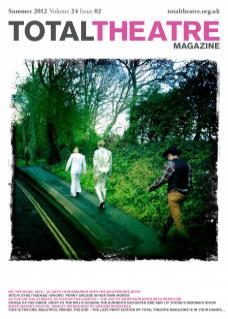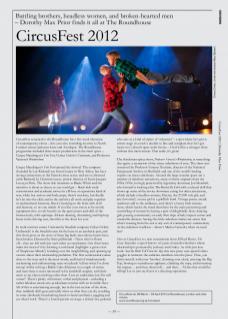CircusFest returned to the Roundhouse for a five-week showcase of contemporary circus – this year also extending its arms to North London venues Jacksons Lane and Artsdepot. The Roundhouse programme included three major productions in the main space – Cirque Mandingue’s Foté Foré, Cirkus Cirkör’s Undermän, and Professor Vanessa’s Wondershow.
Cirque Mandingue’s Foté Foré opened the festival. The company (founded by Luc Richard) are from Guinea in West Africa, but have strong connections to the French circus scene, and are co-directed (with Richard) by Christian Lucas, artistic director of Ecole Jacques Lecoq in Paris. The show title translates as Black/White and the narrative is about as cheesy as you could get – black kids trade contortionist and acrobatic moves in a B-boy or capoeirista kind of way; white boy arrives and body pops; there’s mockery, but finally he’s let into the club; and in the end they all work and play together in multicultural harmony. But it’s bursting to the brim with skill and humour, so no one minds. If you like your circus to be mostly equipment-free, to rely heavily on the pure power and skill of the human body, with uptempo African dancing, drumming and hip-hop beats in the driving seat, then this is the show for you!
In stark contrast comes Undermän by Swedish company Cirkus Cirkör. ‘Undermän’ is the Swedish term for the base in an acrobatic pair, and this show gives us the story of three big burly men whose hearts have been broken. Deserted by their girlfriends – flyers who’ve flown off – they are left with just each other as consolation. Our three bears make the most of it by forming a rock band (highlight: a great cover of ‘Suspicious Minds’), bonding over the weightlifting, and opening up on-mic about their relationship problems. The first confessional comes close to the start and is the most wordy, and kind of simultaneously enchanting and embarrassing; man two pleads ‘tell me what I’ve done wrong’ whilst solving a Rubik Cube dilemma in a couple of twists; and man three is more interested in his kettlebell weights, with little more to say about anything other than ‘I am an undermän, but I’m still a man!’. There’s plenty of humour, verbal and physical – including a rather fabulous mock-arty-acrobalance routine with an invisible flyer. All of this is entertaining enough, but in the last section of the show, they suddenly shift gear and really show us what they can do, resulting in some absolutely breathtaking hand-to-hand acrobatics, juggling and cyr wheel work. There’s a fourth person on stage: a skinny boy guitarist who acts as a kind of cipher of ‘otherness’ – a spot where he’s given centre-stage (to crush a ukulele to bits and complain that ‘he’s got issues too’) doesn’t quite work for me – I feel it’d be a stronger show without this intervention. That aside, it’s great!
The third main space show, Professor Vanessa’s Wondershow, is something else again: a recreation of the circus sideshows of yore. The show was conceived by Professor Vanessa Toulmin, director of the National Fairground Archive in Sheffield, and one of the world’s leading experts on circus sideshows. Around the large circular space are a number of sideshow attractions, many of them originals from the 1930s-1950s, lovingly preserved by legendary showman Jon Marshall, who himself is looking after The Butterfly Girl with a relaxed skill that shows up some of the novice showmen caring for other attractions, which include a headless woman; Electra, the 27,000 volt girl; and (my favourite!) a teeny girl in a goldfish bowl. Vintage penny arcade machines add to the ambience, and there’s a funny little cinema show, which bucks the trend elsewhere for the male presenting and controlling of women by having a pair of delightfully dizzy dancing girls passing commentary on early film clips of lady trapeze artists and vaudeville dancers. Seeing this little sideshow makes me aware that what’s missing from the rest is any sort of contemporary commentary on the sideshow tradition – where’s Marisa Carnesky when we need her?
Also at CircusFest is a new commission from Il Pixel Rosso, The Great Spavaldos, a spoof history of a pair of aerialist brothers whose relationship is poisoned by jealousy and rivalry. As with previous work And the Birds Fell From the Sky, this new piece uses special video goggles to immerse the audience members into the piece. Thus, you find yourself, with your ‘brother’, donning your cloak, entering the Big Top, bowing to tumultuous applause, climbing the rope, and mounting the trapeze… and then, drum roll… and then… Ah but that would be telling! Let us just say that it is a dizzying experience.
CircusFest ran 28 March – 29 April 2012 at Roundhouse, London and other venues. www.roundhouse.org.uk/circusfest

